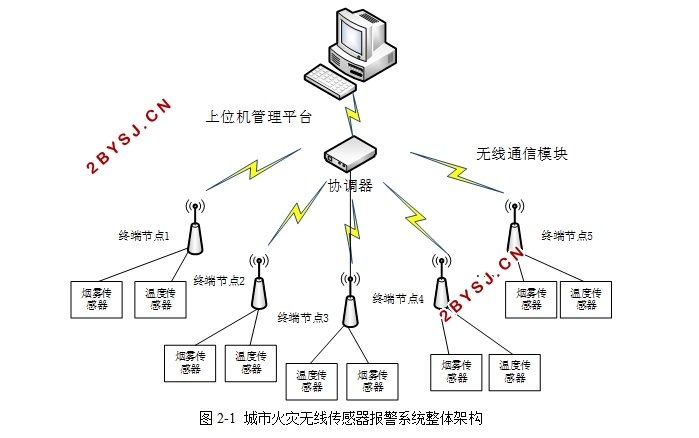城市火灾无线传感器报警系统设计
无需注册登录,支付后按照提示操作即可获取该资料.
城市火灾无线传感器报警系统设计(论文13000字)
摘要:随着社会的发展,城市火灾安全防护越来越重要。基于该背景,本文主要论述了城市火灾无线传感器报警系统的设计与实现。本文选择ZigBee无线技术来完成整体结构的设计。硬件部分采用的是CC2530芯片、温度传感器和烟雾传感器,软件部分则是在Z-Stack协议栈的基础上进行程序的整体修改与设计。上位机部分在Qt软件的基础上使用C++编写。将传感器插在终端节点上,终端节点将传感器感知的周围环境数据以无线的方式发送给协调器,协调器通过串口将数据显示于上位机。上位机部分能够显示不同节点的当前测量值,并且可以进行阈值设置。当发生火灾时,温度和烟雾值超出阈值,数值显示背景变红报警。
关键字:城市火灾;ZigBee;CC2530;传感器;Qt
Design of Urban Fire Wireless Sensor Alarm System
Abstract:With the development of society, urban fire safety protection becomes more and more important. Based on this background, this paper mainly discusses the design and implementation of urban fire wireless sensor alarm system. This paper chooses Zigbee wireless technology to complete the whole design of the structure. The hardware part uses CC2530 chip, temperature sensor and smoke sensor, while the sofeware part is based on Z-Stack protocol, with which it complete the whole modification and design of the program. Based on Qt software, the host computer part uses C++ to design program. We insert the sensors into the terminal nodes, and then the terminal nodes will send the sensor-aware date to the coordinator in a wireless way. At last, the coordinator will show the date on the host computer through serial port. The host computer part can display the current measured value of different nodes. Besides, it can set the threshold. When a fire occurs, the value of temperature and smoke exceed the threshold and the background of the date will turn red to alarm.
Key words: city fire; Zigbee; CC2530; sensor; Qt

目 录
1 绪论 1
1.1课题的研究背景 1
1.2国内外研究现状 1
1.2.1国外研究现状 1
1.2.2国内研究现状 2
1.3无线传感器网络的介绍 2
1.4本文主要研究内容和结构安排 2
2系统总体设计分析 3
2.1无线通信网络技术的选择 3
2.2系统需求概述 4
2.3系统总体设计 5
2.3.1传感器模块 5
2.3.2无线通信模块 6
2.3.3上位机管理平台 6
3系统硬件设计 6
3.1数据采集模块设计 6
3.1.1温度采集电路设计 7
3.1.2烟雾采集电路设计 7
3.1.3电源模块硬件设计 8
3.2无线通信模块 8
3.2.1ZigBee芯片选择 8
3.2.2模块设计 8
3.3串行通信接口电路硬件设计 9
4系统软件设计 10
4.1ZigBee无线网络软件设计 10
4.1.1ZigBee开发环境介绍 10
4.1.2网络拓扑结构 10
4.1.3Z-Stack协议栈 11
4.2下位机程序设计 12
4.2.1系统整体框架 12
4.2.2温度、烟雾传感器程序设计 12
4.2.3协调器程序设计 13
4.2.4终端节点程序设计 14
4.3上位机程序设计 15
4.3.1软件开发环境介绍 15
4.3.2上位机实现的功能 15
5系统总体测试 16
6总结与展望 18
6.1总结 18
6.2展望 18
参考文献 19
致谢 20
